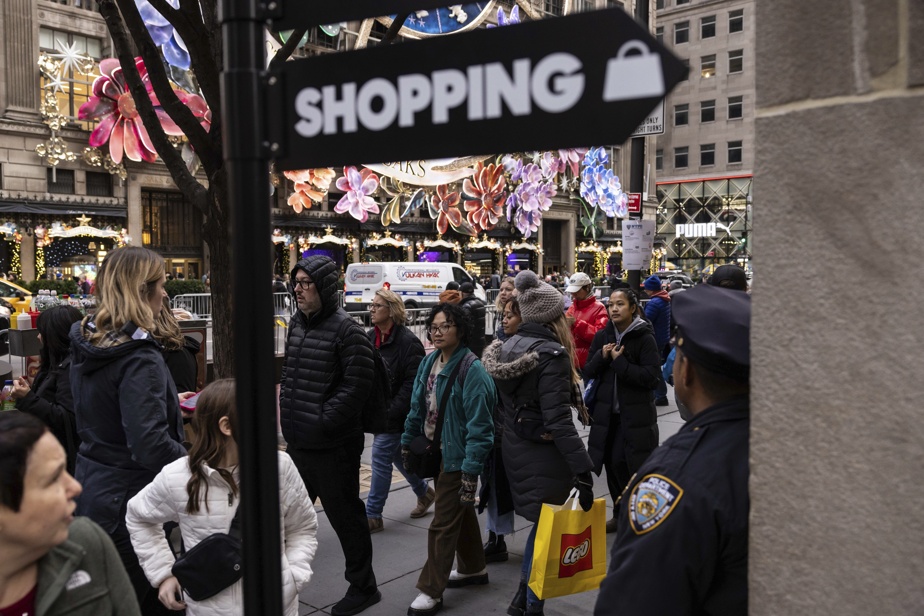(New York) Americans unexpectedly increased their spending from October to November as the unofficial holiday season kicked off, underscoring the power of shoppers despite high prices.
Retail sales rose 0.3% in November compared with October, when sales fell a revised 0.2%, the Commerce Department said Thursday. Sales were expected to decline again in November due to a myriad of factors, including uncertainty surrounding the economy. Excluding car and gasoline sales, sales increased 0.6%.
As they have for most of the year, American consumers, an important engine of economic growth in the United States, visited stores, shopped online or went to the restaurant.
Sales at restaurants increased 1.6%, while sales at furniture stores rose 0.9%. Online sales increased 1%. Sales at clothing and accessories stores increased 0.6%. Sales of electronics and household appliances, however, fell 1.1%. Department store sales fell 2.5%. Figures are not adjusted for inflation.
Americans’ desire to spend seems to have some room to maneuver, even after a prosperous summer. Consumer spending jumped in the July-September quarter. Economists expect spending to slow in the last three months of the year, due to rising credit card debt and late payments, as well as falling savings.
“As consumers continue to face obstacles such as higher borrowing costs, tighter credit conditions and high prices, a still strong job market, a positive income trend and easing pressures on prices should keep spending and growth positive for now,” wrote Rubeela Farooqi, chief U.S. economist at High Frequency Economics.
Last week, U.S. employment data showed that employers added 199,000 jobs in November and the unemployment rate fell to 3.7%. In just over a year, inflation has fallen from a worrying 9.1% to 3.2%. Although that figure is still higher than desired, the economy is, by most estimates, expected to avoid the recession that many economists feared, a potential side effect of U.S. attempts to curb inflation.
Still, people remain gloomy, according to the University of Michigan Consumer Confidence Index. Preliminary figures for December released on Friday show that sentiment has improved as more people view inflation as slowing.
Additionally, many economists are concerned about how consumers pay for all these goods. Stores implemented deeper and earlier discounts on products for the holiday season. Mark Cohen, director of retail studies at Columbia Business School, thinks stores have stepped up their discounts to entice consumers to buy.
Ted Rossman, senior industry analyst at Bankrate, notes that credit card balances and rates are at all-time highs.
“It feels like the holiday hangover might be particularly nasty this year,” he said.
Thursday’s strong retail trade numbers were particularly surprising given some of the news coming from the retailers themselves.
Over the past quarter, retailers such as Walmart and Macy’s said consumers were more selective in their purchases as the holiday season approached.
Walmart attracted bargain-seeking shoppers, but its forecast for the future remained subdued. Target’s sales fell, although the chain did better than many industry observers expected.
Home Depot’s sales also declined as customers postponed home improvements and purchases of big-ticket items, such as appliances and other goods often purchased with credit cards.
Yet the National Retail Federation, the nation’s largest retail trade group, still expects consumers to spend more during the 2023 winter holidays than last year.
In November, the group forecast that U.S. Christmas sales would increase 3 to 4 percent for the months of November and December. This figure is lower than the 5.4% growth recorded during the same period a year ago, but is more in line with the average annual increase of 3.6% recorded between 2010 and 2019, before the pandemic .
Black Friday was expected to once again be the busiest day of the season, even though sales became more spread out. But retailers still have six of the 10 busiest days of the season ahead of them, including Dec. 26, according to Sensormatic Solutions, which tracks store traffic. On average, the ten busiest days in the United States account for approximately 40% of total holiday store traffic, according to Sensormatic Solutions.
Ethan Chernofsky, vice president of marketing at Placer.ai, which tracks people’s movements based on cellphone usage, noted that Black Friday traffic was heavy. But there is also a group of buyers who will be waiting for good deals as the holidays approach.
These buyers are “ready to play this game […] until the last possible minute,” he explained.
The government’s monthly retail sales report offers only a partial snapshot of consumer spending; it does not include many services, including health care, travel, and hotel accommodation.
